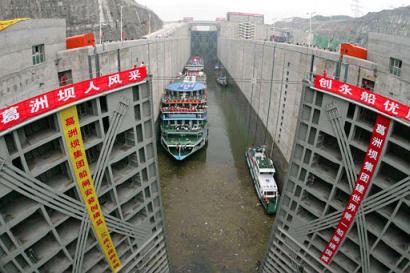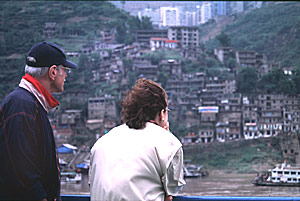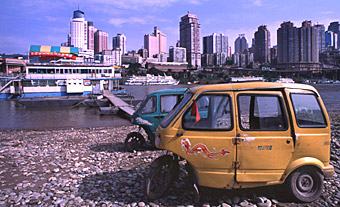Dam it!
Love it or hate it, China's controversial Great Wall of Concrete has been cast across the Yangtze. Now, as the water rises, the world's greatest construction site is already an odd tourist site in its own right.
By Ron Gluckman/On the Yangtze River, China
THREE MEN HAVE BEEN ROOTED TO THE TOP DECK since the very start of our four-day river cruise, drinking beer, generally avoiding fellow passengers and on-board activities. But, as the engines cut from roar to a steady hum, and the boat glides through an unusually deep, calm stretch of the Yangtze River, the diffident trio suddenly come alive.
 "Can
you believe it?" asks one, eyes wide at first sight of what all three have
come around the world to see. Then, they fall silent, simply staring over the
rails in rapt wonder.
"Can
you believe it?" asks one, eyes wide at first sight of what all three have
come around the world to see. Then, they fall silent, simply staring over the
rails in rapt wonder.
Such reactions are typical of cruises through China's Three Gorges, whose scenery has inspired poets and painters through the centuries. Although, admittedly, none has been inspired by this particular sight. "Beautiful," another of the men declares. Then they all nod, euphorically soaking up the splendor of the world's largest concrete wall.
Beauty, we are regularly reminded, is in the eye of the beholder. For those with a soft spot for man-made wonders, there may be no sight on Earth as fetching as the 610-foot tall, 1.3-mile wide Three Gorges Dam.

There were, as befits any sizeable project, an equally long list of detractors. In between have muddled, as always, the masses.
Millions, in fact, travel this river annually, but never in such numbers. This past year, perhaps 20 million tourists flooded the Three Gorges, hungry for a final look at the scenery before the dam turns much of this river into a 650-kilometer long lake, half the length of California.
That rise begins in June. Hence, most aboard Princess Jenny, among a dozen luxury boats plying the Yangtze, have come to soak up the ancient wonders of the Gorges - before they are gone.
These sights include breathtaking hillside temples, carved into towering, sheer cliffs, dramatic natural vistas and, more simply, an endless procession of tile roofs, picturesque barges and boats that mark hundreds of tiny towns dozing on the Yangtze shore for eons.
That many of these villages, and some sights, too, will soon be submerged by swelling waters due to rise up to 175 meters makes our tour all the more compelling - and titillating, as if we, on board, are being favored with special vistas that will soon be obliterated, except from our memories.
Of course, not all aboard share the same nostalgic obsession with the timeless sights. Even as most passengers spin, oohing and aahing each old stone bridge or trickling waterfall, the dam-spotters atop the sun deck serve notice that, in the future, many will come not to see the Three Gorges of old, but the new version.
 That different strokes should spark
different folks really shouldn't surprise anyone, myself included. After all, I
had fair warning before setting out from Chongqing, the booming Yangtze town
that is the usual gateway for Gorge cruises.
That different strokes should spark
different folks really shouldn't surprise anyone, myself included. After all, I
had fair warning before setting out from Chongqing, the booming Yangtze town
that is the usual gateway for Gorge cruises.
"The end of the Three Gorges? Ridiculous," says John Burger, when we meet for coffee at Chongqing Hilton Hotel, where he is director of business development. "We're getting a whole new product to promote. Everyone has been talking about what would be lost when the dam started filling. But we're also getting new scenery, new routes opening up to tourism.
"And another thing," he warns prophetically, "just wait. People will come just to see the dam, the locks. Already they are here."
Many more will follow in coming months, when the dam offers numerous firsts for those with a thirst for such thrills. As the dam starts filling in June, water will rise 135 meters in just two weeks.
By mid-July, big boats will be able to traverse the area for the first time since November, when a temporary diversion channel was closed to allow the final pouring of an estimated 30 million cubic meters of cement.
Since then, cruise ships have been confined to one side of this new Great Wall; most toured upstream, amongst the Three Gorges and the best scenery.
 Starting this summer, though, cruises
can resume the usual Chongqing-Wuhan route, but
with startling differences. Passage for big boats will be via a series of five
locks, each the size of a football pitch.
Starting this summer, though, cruises
can resume the usual Chongqing-Wuhan route, but
with startling differences. Passage for big boats will be via a series of five
locks, each the size of a football pitch.
Ships up to 3,000 tons can use the world's largest elevator, which will lift them over the height of a Statue of Liberty in under 45 minutes.
Also this summer, the first turbines will spin at the world's biggest hydroelectric plant. By 2009, when water reaches a depth of 175 meters, all 26 turbines will be on line, producing 85 billion kilowatt hours per year - over 10 percent of China's power.
Long before then, tour boats will map routes to little-seen sights along new channels. These include ancient coffins in the cliffs seen only by adventurous travelers in the past.
Changes should be minimal in the Three Gorges, Chinese officials say, with water levels in Qutang and Wuxia gorges set to rise by 9-16 meters. Xiling Gorge, largest of the three, and closest to the dam, will see rises of 46 meters. Yet with mountains towering 1,000-1,500 meters on both sides, cruise passengers will still be craning their necks.
Bigger changes, of course, face the people and places on the shore. More than a million residents will be relocated, and hundreds of towns, roads and bridges rebuilt.
Dam backers note that new homes will be wired with electricity and other modern facilities, unlike the mostly medieval huts being replaced. Critics counter that an entire slice of human history has been cut away from the Yangtze, and uprooted settlements, with their unique river routines and rituals, can never be replanted elsewhere.
Indeed, one sees the change already, on any trip along the Yangtze. Pole men, who haul cargo from boats on bamboo poles up the slopes of steeply-structured river towns, were once plentiful in the clutter of narrow alleys crisscrossing the hillsides of Fuling, Fengdu and Fengjie.
 Stop here now - well except in Fengjie;
it's already underwater - and you will still see the striking, slight, muscular
men, but not much longer. Already most of these ramshackle river towns have
moved to higher ground, where goods move by new road on vehicles, rather than on
the backs of the ancient pole men.
Stop here now - well except in Fengjie;
it's already underwater - and you will still see the striking, slight, muscular
men, but not much longer. Already most of these ramshackle river towns have
moved to higher ground, where goods move by new road on vehicles, rather than on
the backs of the ancient pole men.
Chalk it up to progress, which has churned the Yangtze waters through time, despite what romantics choose to believe.
Take tracker trips, popular on Three Gore itineraries. Tourists disembark cruise ships for tiny "pea boats" up river tributaries, paddled, pulled and pushed by barefoot men.
They clamber up cliffs to inch boats along, clawing the footprints carved into the rock by the feet of countless ancestors.
Most evocative, since men died by the hundreds on the perilous Yangtze passageways. But these were long ago widened with dynamite. The trackers became obsolete, except in tourist sideshows.
As the waters rise, these trackers will survive, shifted to some new scenic canyons. "We'll just adjust, with new routes, new sights, new itineraries," promises Howard Chen, cruise director for the Regal China line, who is from Wuhan and has spent his entire life along the waterway that author Pearl Buck called the "wildest, wickedest river on Earth."
 Chen says: "Big changes are afoot,
for sure, but we'll ride this out. We've been doing the same along the Yangtze
for years and years."
Chen says: "Big changes are afoot,
for sure, but we'll ride this out. We've been doing the same along the Yangtze
for years and years."
Comforting thoughts as one leans on the railing of a boat gliding through the gorges. From this vantage point, lost in the mists of time, change seems a reassuring constant on a magnificent river.
The dam isn't the end of the Three Gorges. A new beginning seems crass, but as the three men on the top deck point out, it already seems to be the newest attraction on what has long been one of the greatest shows on Earth.
Ron Gluckman is an American reporter who has been roaming around Asia since 1991, when he was based in Hong Kong. Since 2000, he has been based in Beijing, covering China for a wide variety of publications including Morning Calm, the magazine of Korean Airlines, which ran this story as the dam was completed and reopened to boat traffic in June, 2003.
For other stories on the Three Gorges, look at Ron Gluckman's story for the Asian Wall Street Journal and Destinasian.
For booking and other info, turn to Three Gorges information.
Top photo, of the opening of the dam, from the wires. All other photos by Ron Gluckman.
To return to the opening page and index
push here
[right.htm]
